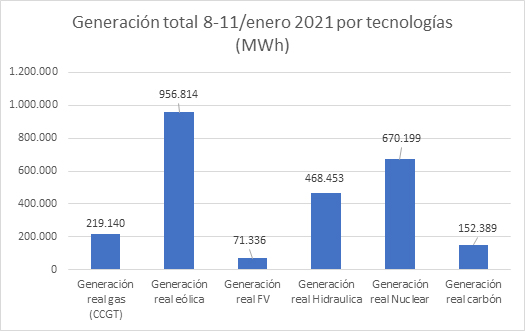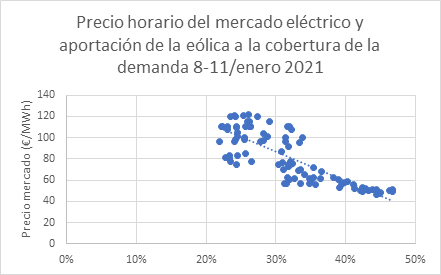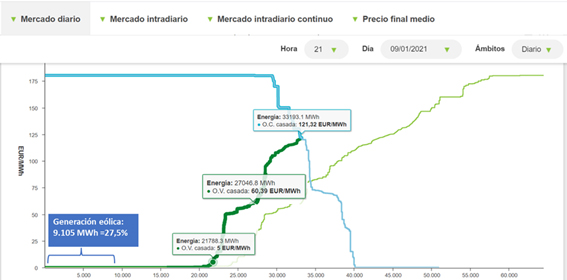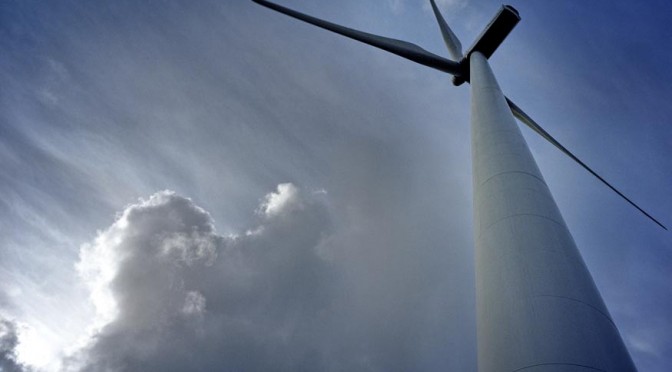In the hours in which it has covered more than 38% of the demand is when the price of the electricity market has been cheapest.
The average wind contribution on the dates between January 8 and 11, during the storm Filomena as it passed through Spain, has been 30.8% of the peninsular demand, reaching 47% of generation of the mix and at no time less than 20%.
Thanks to this significant contribution from wind power, the price of electricity has not increased further. The high prices in the electricity market are not due to the low production of wind power at this time.
In the hours when wind power has covered more than 38% of the demand, it is when the price of the electricity market has been cheapest during the four days.
From Friday, January 8 to January 11, according to REE data, wind generation was the main generation technology.
Demand coverage with wind power never dropped below 20% and reached 47% in the middle of the Filomena storm. On average, wind power contributed 30.8% to the coverage of peninsular demand during the dates of January 8 to 11.
In the hours when wind power has covered more than 38% of the demand, it is when the price of the electricity market has been cheapest during the four days.
Without exceptional wind generation during the four days (January 8-11), the average price of the electricity market would have been € 26.24 / MWh higher than the one that finally existed.
The main causes of the high prices in the electricity market have been the exceptional increase in demand for electricity and gas for heating, together with high prices for this fuel in the Spanish and Asian markets (due to low temperatures and a problem of pipeline supply from Algeria) and the rise in the price of CO2 (which is at record levels).In the days after Filomena’s passage, in some forums and media, the rise in the price of electricity has been blamed, among other reasons, on the lack of generation with wind. From AEE, we would like to ensure that when a storm passes there is a lot of wind, a lot of electricity is generated and this helps to contain the prices of the electricity market.
As can be seen in the following graph, from Friday, January 8 to January 11, according to REE data, wind generation was the main generation technology.

Source: REE and AEE elaboration
Also, as can be seen in the following graph, the hours when wind power has covered more than 38% of the demand is when the price of the electricity market has been the cheapest during the four days:

Source: REE, OMIE and PREPA elaboration
As can be seen in the graph, the coverage of demand with wind power never fell below 20% and reached 47% in full storm Filomena. On average, from Friday to Monday, wind power contributed 30.8%.
According to data from REE and OMIE, in general terms, the highest market prices occurred in hours with less than 35% coverage, while the lowest prices occurred with percentages of wind power greater than 37%.
If we analyze an hour with a very high price (€ 121 / MWh), between 21 and 22 on January 9 (Saturday) it can be seen that there was an unusual demand for electricity for a winter Saturday night of 33.1 GWh (13% more than a year ago when it was 29.3 GWh). The contribution of wind power was 27.5%, and as can be seen in the OMIE graph, 21.8 GWh of electricity had been offered to the market (including wind power) at less than € 5 / MWh.
As can be seen in the graph, the extraordinary price increase occurs when demand exceeds 27 GWh, when it goes from € 60 / MWh to € 121 / MWh due to an increase in demand of 6 GWh.

Source: OMIE, REE and PREPA elaboration
If there had not been more wind generation than usual, the market price would have been much higher because the matching curve would have shifted further to the left, resulting in higher prices.
Without exceptional wind generation during the four days (January 8-11), the average price of the electricity market would have been € 26.24 / MWh higher than the one that finally existed. That is, instead of having an average market price during the four days of € 82.66 / MWh, without an exceptional contribution from wind power, the price would have been € 108.9 / MWh.
The main causes of the high prices in the electricity market have been the exceptional increase in demand for electricity and gas for heating (6.18% and 12.6% respectively compared to the same weekend last year), together at high prices for this fuel in the Spanish market (in the Spanish spot market it was € 52 / thermal MWh, when on Monday, January 4, it was still € 27.83 / thermal MWh, due to the cold and a supply problem due to gas pipeline from Algeria), and in Asia (with the diversion of LNG ships to those markets), and the rise in the price of CO2 (which is at record levels, with an increase of 43.5% compared to the same period of the year past).

